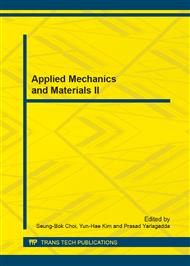p.514
p.519
p.524
p.531
p.535
p.539
p.543
p.547
p.553
Analysis on Railway Ballast-Glue Micro-Characteristics
Abstract:
Ballast-glue is a chemical material severed to adjust ballast stiffness and stabilize railway infrastructure, and its ballast-glue characteristics is less of microscopic research. The ballast-glue cubic sample compressed tests were carried, with curing time alteration, then a 3D discrete-element method (DEM) is used to investigate the glue bonding effects of the tests, where the ballast is made of real size irregular clumps, the ballast-glue is represented by bonds to simulate the tensile and shear strength, results show that ballast curing time is a key factor to govern the ballast-glue integrity and strength, ballast-glue increases the maximum compressed force up to 0.99Mpa, and the DEM bonding function is a potential tool for ballast-glue structure investigation.
Info:
Periodical:
Pages:
535-538
Citation:
Online since:
December 2013
Authors:
Price:
Сopyright:
© 2014 Trans Tech Publications Ltd. All Rights Reserved
Share:
Citation:


